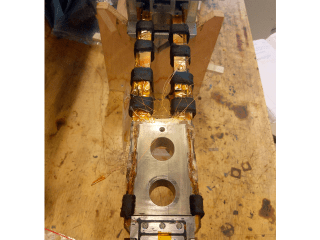From
Timetable to
Place Amphithéâtre J. Talairach, CEA Saclay - NeuroSpin, bâtiment 145 Allée des Neurosciences 91190 Saint Aubin
Effect of the mechanical stress on the training of Nb₃Sn superconducting magnets
High field Nb₃Sn superconducting magnets are promising for use in future high-energy particle colliders. To date, many superconducting magnets impregnated in epoxy have been tested. Extreme conditions in terms of current, magnetic field, and Lorentz forces generate sudden resistive transitions (quenches) that contribute to the training of magnets. Many have struggled to reach their expected performances, often needing long training. Multiple mechanical causes of these training have been identified, such as cracking of the epoxy resin, failure of epoxy-to-metal component bonding, and displacement inducing friction, among others. The objective of this work is to understand the causes of these phenomena and their link with the pre-stress applied to the coils. This could help to significantly reduce the number of quenches and increase the maximum quench current during the training phase of magnets. A campaign was carried out to reproduce the detachment phenomena of an Nb₃Sn cable in conditions representative of superconducting magnets, here a current around 20 kA with an applied field of 11 T. An existing experimental set-up was redesigned. It allowed the average pre-stress applied on the cable to measure accurately a low compression stress corresponding to an average value of 10 MPa of stress. Four powered samples based on Nb₃Sn Rutherford cables were subjected to a gradual release of the transverse compressive stress. It was found that the cable performance was lowered if the applied transverse pre-stress was decreased under values that depend on the epoxy bond with the sample holder. Similarly, the training behavior was shown to be influenced by pre-stress. In the case where the cables of an Nb₃Sn magnet are subjected to shear stress, this work suggests that maintaining a minimum level of compression on the coils could be necessary to achieve the expected performance and to minimize training.
Composition du jury :
- M. Hans VAN OORT University of Twente Rapporteur
- M. Carmine SENATORE University of Geneva Rapporteur
- M. Guillaume KERMOUCHE Ecole des Mines de Saint-Etienne Examinateur
- M. Gerard WILLERING European Organization for Nuclear Research (CERN) Examinateur
- Mme Anna KARIO European Organization for Nuclear Research (CERN) Invitée
- M. Simon OTTEN Royal SMIT Transformers B.V Invité

